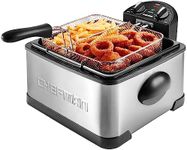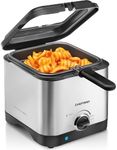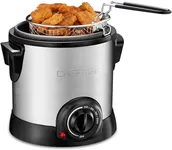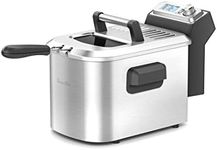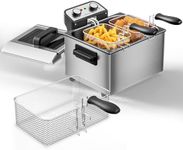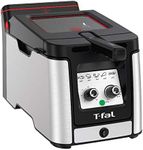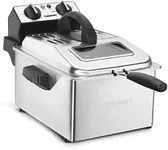Buying Guide for the Best Deep Fat Fryers
Choosing the right deep-fat fryer can make a big difference in your cooking experience, whether you want to make crispy fries, fried chicken, or doughnuts at home. The key is to match the fryer’s features to your cooking habits and kitchen space. Understanding the main specifications will help you find a fryer that’s safe, easy to use, and delivers the results you want.CapacityCapacity refers to how much oil and food the fryer can hold at one time. This is important because it determines how much food you can cook in a single batch. Small fryers are great for individuals or couples, as they use less oil and take up less space, but they can only cook small portions. Medium-sized fryers suit small families, while large-capacity fryers are best for bigger households or for entertaining guests. Think about how many people you usually cook for and choose a capacity that matches your needs, so you don’t have to cook in multiple batches.
Power (Wattage)Power, measured in watts, affects how quickly the fryer heats up and how well it maintains the frying temperature. Higher wattage fryers heat up faster and recover temperature more quickly after adding food, which helps achieve crispier results. Lower wattage models may take longer to heat and can struggle with larger batches. If you plan to fry often or cook larger amounts, a higher wattage fryer will be more efficient. For occasional or light use, a lower wattage model may be sufficient.
Temperature ControlTemperature control lets you set and maintain the oil at the right heat for different foods. Some fryers have adjustable thermostats, while others have fixed settings. Adjustable controls are more versatile, allowing you to fry a wider range of foods at their ideal temperatures. If you want to experiment with different recipes or need precise control, look for a fryer with a clear, adjustable temperature dial. If you only plan to make basic fried foods, a simple model with preset temperatures may be enough.
Safety FeaturesSafety features are designed to prevent accidents and make frying safer. Common features include cool-touch exteriors, locking lids, automatic shut-off, and overheat protection. These are especially important if you have children or pets at home, or if you’re new to deep frying. If safety is a top concern, prioritize models with multiple safety features to reduce the risk of burns or oil spills.
Ease of CleaningCleaning a deep-fat fryer can be messy, so features that make this easier are valuable. Look for fryers with removable oil containers, dishwasher-safe parts, and non-stick interiors. These make draining oil and washing up much simpler. If you want to avoid hassle after cooking, choose a model designed for easy cleaning, especially if you plan to use it frequently.
Odor and Oil FiltrationOdor and oil filtration systems help reduce cooking smells and keep the oil cleaner for longer. Some fryers have built-in filters that trap odors and filter out food particles. This is important if you’re sensitive to cooking smells or want to reuse oil multiple times. If you plan to fry indoors often or in a small space, a fryer with good filtration will keep your kitchen fresher and your oil in better condition.
Size and StorageThe physical size of the fryer affects where you can keep it and how easy it is to store. Compact models are easier to fit in small kitchens or cupboards, while larger fryers may need a dedicated spot on your countertop. Consider your available space and how often you’ll use the fryer. If you have limited storage, look for a model with a compact design or one that’s easy to disassemble and store.

